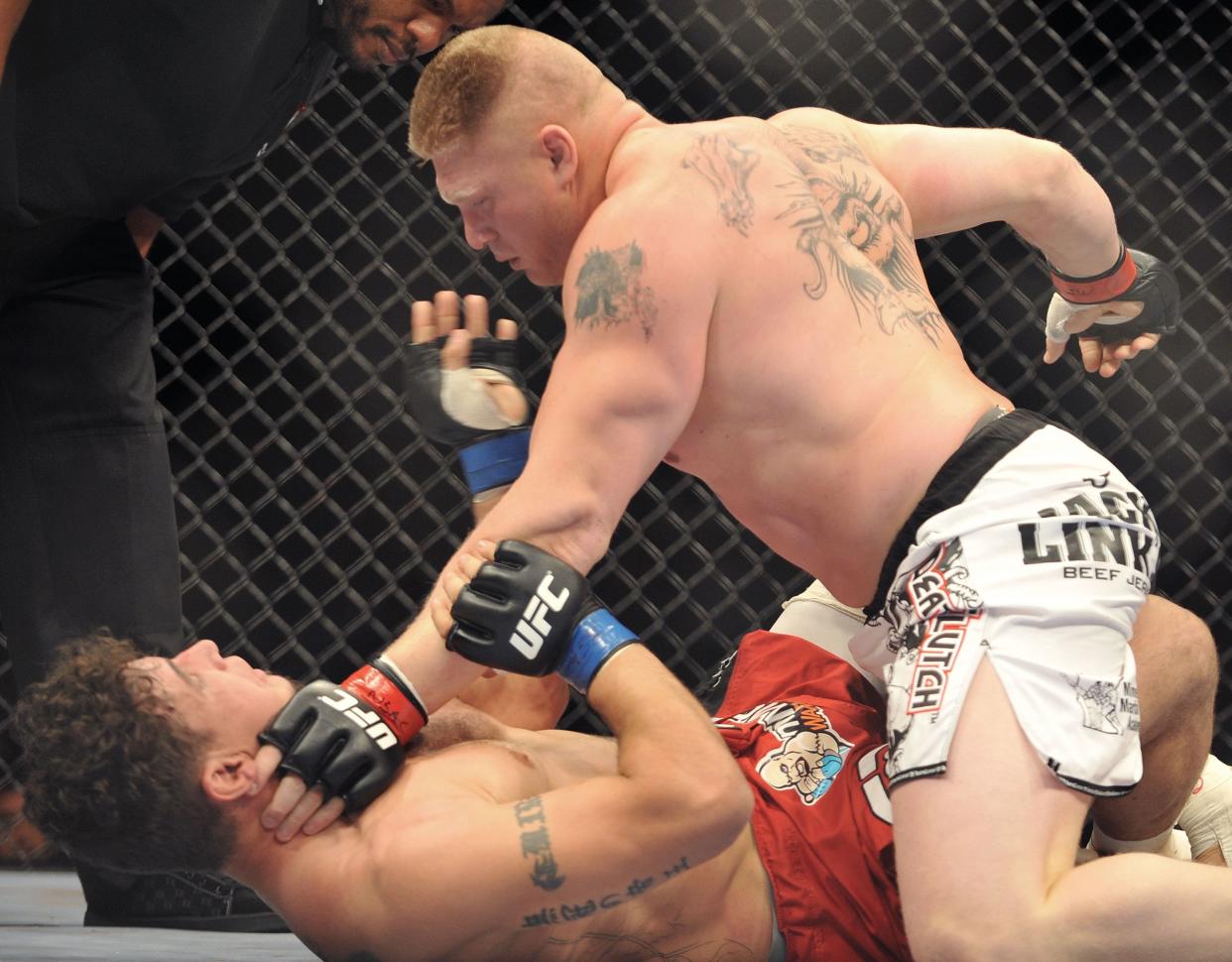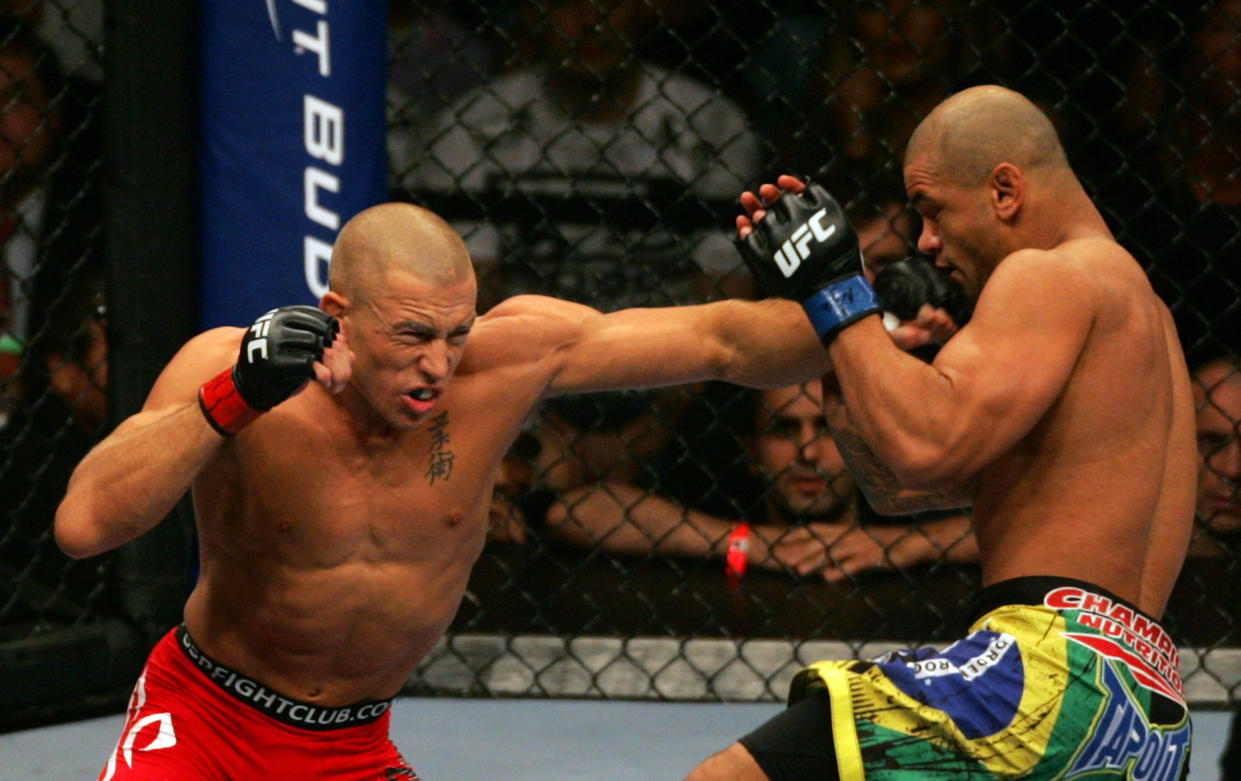UFC 100: 15 years later, let's remember the event that flexed the muscle of MMA's newfound might

The big man turned his head slowly to look at me as I gave him the news. Naively, I’d assumed he already knew. It was all over the internet by then, or at least the little MMA quadrant of it. Word had spread quickly that Frank Mir was officially out of his planned heavyweight title fight main event against Brock Lesnar at UFC 98.
But somehow no one had thought to tell Lesnar yet, so when I asked what he thought of this new development I was inadvertently breaking the news to him. Lesnar and his wife, Rena (better known to pro wrestling fans at the time as Sable), both turned to look at me like I was a bug who’d just landed in their soup.
This was March 2009. The big rematch with Mir was supposed to be in May. Lesnar had come to Columbus, Ohio, for the Arnold Classic in order to make a promotional appearance for a sponsor. I was there to do a story on him for a magazine, and we weren’t off to the best start. We’d just met and here I was "lying" to him.
“No way,” Lesnar said after I showed him the online report on my phone. “I’d have heard something.”
By the next morning when I met him for an interview over breakfast at his hotel, he had. It was all true. Mir was out of the fight. Lesnar was despondent. All the money he was going to make from that fight — and Lesnar loved money, insisting there was “no such thing” as enough of it — and now he could only shake his head as it slipped through his enormous fingers.
What he couldn’t have known then was how well it would all work out in the end. Extremely well, in fact. As in, he’d soon find himself in the headliner of the top-selling UFC event of all time up to that point. With it would come an unforgettable place in MMA history.
It was 15 years ago today that UFC 100 went down in Las Vegas’ Mandalay Bay Events Center. It reportedly sold somewhere in the neighborhood of 1.6 million pay-per-view buys, took in more than $5 million at the gate and firmly established the UFC as a major sports organization that was definitely here to stay.
To many current MMA fans, that may seem like a given. It’s easy to look at the UFC of today and assume it was always this way, a fight promotion born fully grown and in total command. But for those who lived through events like UFC 35 (the one where almost everyone got sick in Uncasville, Connecticut) or UFC 37.5 (the one the UFC threw together in an effort to get at least one fight on cable TV for the first time), there was no guarantee there ever would be a UFC 100.

That first centennial event was special for a few different reasons. For one, there was the sheer star power of the thing. Lesnar and Mir in a main-event heavyweight title rematch at the top. Georges St-Pierre, the welterweight champion and the UFC’s “king of pay-per-view,” defending his title against Thiago Alves in the co-main. Then you had a supporting cast that included Dan Henderson creating his own logo with a brutal and frankly mean-spirited knockout of Michael Bisping, plus Yoshihiro Akiyama and Alan Belcher putting on a wild scrap, and Mark Coleman beating back Father Time with an improbable win over the late Stephan Bonnar.
Just to let you know how stacked the card was, Jon Jones fought on the prelims. There were live viewing parties at Radio City Music Hall. It was the first true mega event the UFC ever put on, a fight card you simply could not miss if you cared even a little bit about this sport.
That’s the other thing that made UFC 100 special. For the first time, here was the UFC flexing the full extent of its power. Five years earlier, you could barely even find this sport. The UFC had no TV deal, no reality show. It put on about five events per year, all of them pay-per-views that were considered huge successes if they cracked 100,000 buys.
But by the summer of 2009, the UFC was a behemoth. The centennial event felt like a celebration, like climbing to a high vantage point just to look back upon the desolate valley where you almost died of thirst.
The UFC celebrated not just with the event, but also with its first fan expo. These days the hoopla surrounding “international fight week” every summer in Las Vegas is just expected, but at the time this was all new ground. Tens of thousands of people passed through a giant and yet somehow claustrophobic convention center space in the Mandalay Bay, shaking hands and snapping pictures with nearly everyone of note in the MMA universe. To be there among the sweaty bodies clad in gaudy T-shirts and bedazzled jeans (2009 was a dark time for men’s fashion, I’m afraid) was to be reminded that this weirdo fringe sport had finally fully arrived — for better and worse.
All of this combined to make the entire weekend feel like the can’t-miss gathering for MMA fans. But on fight night, the two biggest pieces of it all were obviously St-Pierre and Lesnar.
St-Pierre had become a bonafide superstar with help from his rivalries with Matt Hughes and B.J. Penn. Both men were already MMA greats when St-Pierre showed up, looking like a computer-generated model of the fighter of the future. He was a superb overall athlete who blended kickboxing and hints of karate with a dynamic submission game. When he suddenly learned to wrestle out of nowhere, despite having no real background in it, he slammed the door on an entire generation’s welterweight title hopes.
Whichever aspect of the sport you were best at — striking, wrestling, jiu-jitsu, it didn’t matter — St-Pierre always had at least two other areas he could beat you in. In the lead-up to UFC 100, I spent time in South Florida with Thiago Alves for a magazine profile. I remember sitting with him at his favorite Asian fusion restaurant (I don’t think I’ve ever seen anyone who loved to eat more than “The Pitbull”) and trying to ask, as politely as I could, where he thought he held an advantage over someone as well-rounded as GSP.
Alves shrugged as he explained that he couldn’t be sure how he’d beat St-Pierre for the title, but he felt sure he would. Then, as he got double-legged nearly a dozen times by St-Pierre, you could see the change on his rapidly swelling face. His belief had turned to hope. The hope got dimmer and dimmer each time he came back to his corner after another round.
(Meanwhile, in the other corner, St-Pierre was telling his coach, Greg Jackson, that he’d pulled his groin. “I don’t care,” Jackson told him. “This is where champions are made. Nothing matters now. Hit him with your groin.”)
But for the masses, Lesnar was still the big appeal. A former WWE wrestler who’d done time in one training camp with the Minnesota Vikings before deciding to commit himself (briefly but memorably) to MMA, Lesnar was a huge deal in this sport the moment he showed up.
UFC 100 was Lesnar’s high-water mark as a fighter, both athletically and financially. He’d never again look so dominant in the cage as he did when he took down Mir and battered him like a caveman fighting over the last hunk of mastodon meat. He’d also never fight on a UFC event that sold more pay-per-views than this one — not even when he returned for the next centennial event at UFC 200.
As mad as he was about his fight being scrapped from UFC 98 (so, so mad), it wound up being the best thing that could have happened for all parties concerned. Adding Lesnar to the top of UFC 100 made an already stacked pay-per-view feel even more massive. It brought the biggest possible spotlight for everyone on the card while also allowing the UFC to show off the full extent of the sports powerhouse it had become.
It even gave Lesnar a huge audience for perhaps his most memorable interview. As the Vegas crowd showered him with boos, Lesnar celebrated the win over Mir by specifically stating that he was going to go home and drink a Coors Light — “That’s a Coors Light, because Bud Light won’t pay me nothing.” — celebrate with friends and family, and then added: “Hell, I might even get on top of my wife tonight.”
This, at least, got him some cheers before he rode off into the sunset. And how was he to know then that, at least for him, and at least in this sport, it would never get much better than this night?


